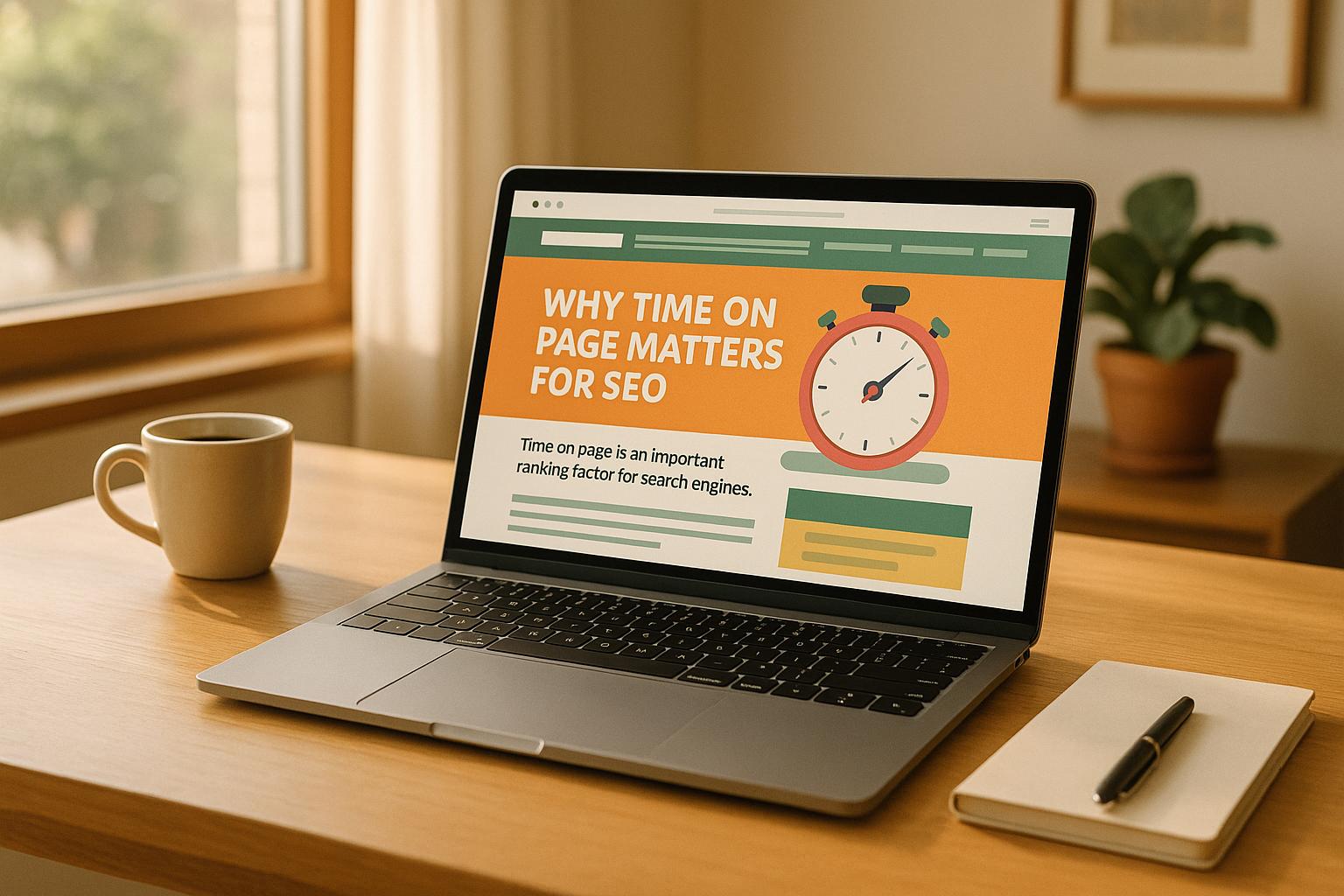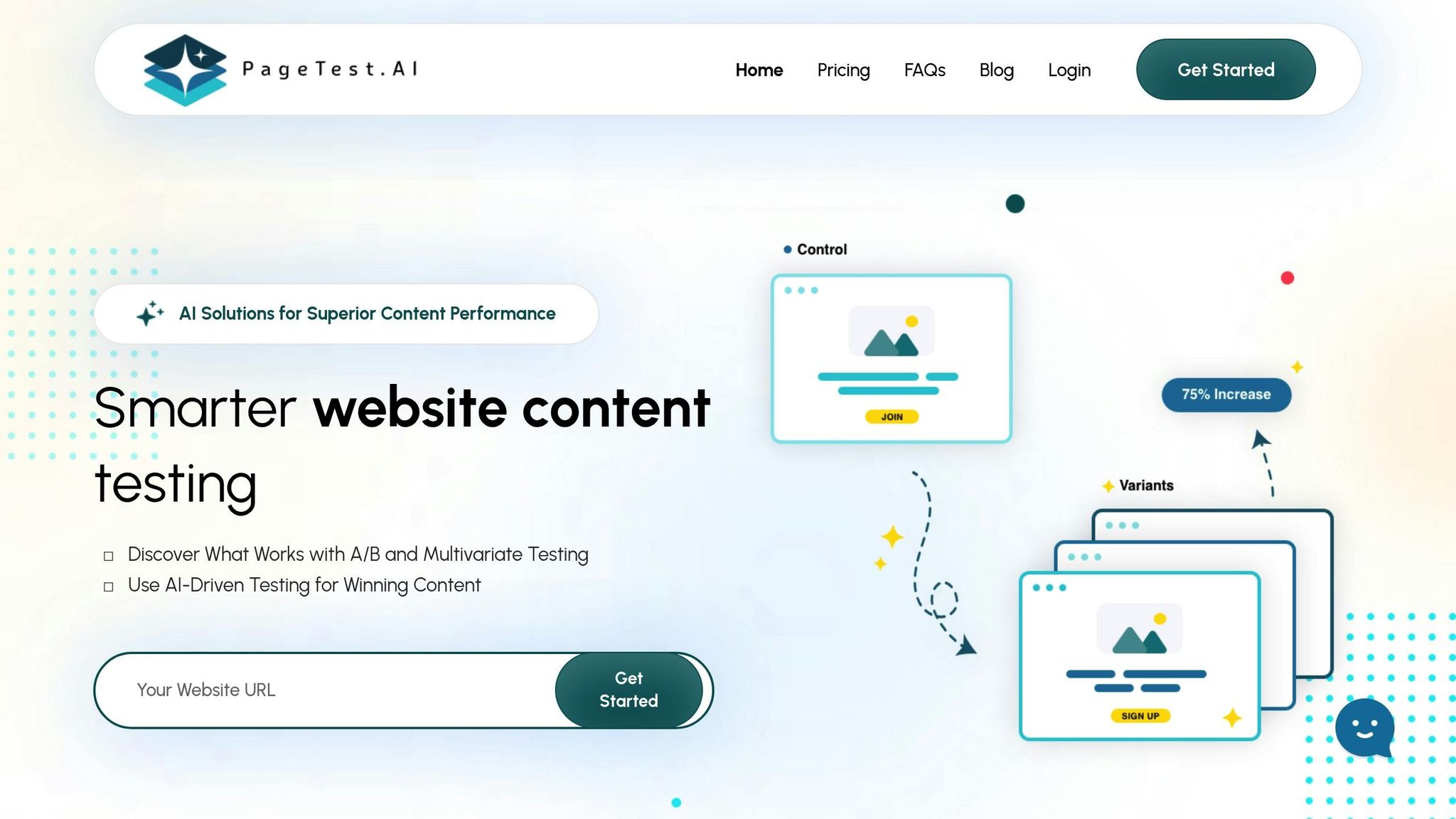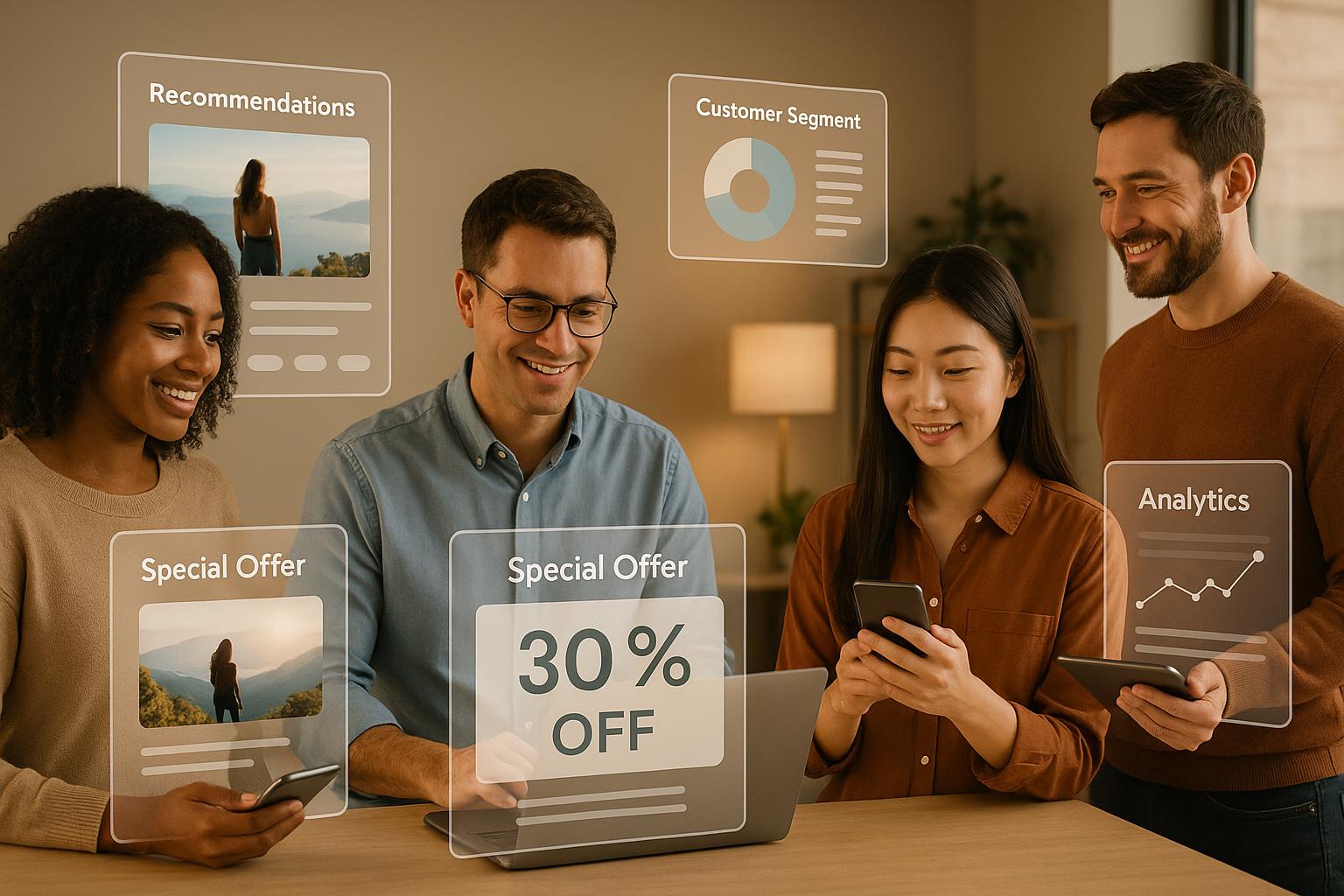

Why Time on Page Matters for SEO

Why Time on Page Matters for SEO
 17-06-2025 (Last modified: 17-06-2025)
17-06-2025 (Last modified: 17-06-2025)
Time on Page is a key metric for understanding how users interact with your content. It measures how long visitors stay on a webpage, offering insights into user engagement and content quality. While it’s not a direct ranking factor, longer Time on Page often correlates with better search engine rankings because it signals to Google that your content is relevant and valuable.
Key Takeaways:
- What It Is: Time on Page tracks how long users actively view a webpage.
- Why It Matters: Longer engagement indicates user satisfaction and aligns with Google’s focus on delivering helpful content.
- SEO Impact: While not a direct ranking factor, it’s an important engagement signal that influences rankings indirectly.
- How to Improve It:
- Create detailed, user-focused content.
- Use visuals like videos and infographics.
- Add interactive elements like quizzes and polls.
- Optimize site speed and mobile usability.
By improving Time on Page, you enhance user experience, align with Google’s algorithms, and increase your chances of ranking higher in search results.
#079 SEO Tutorial For Beginners – Bounce Rate, Dwell Time, On Page Time and SEO
Common Myths About Time on Page
Time on Page is often misunderstood, leading to widespread SEO myths. Let’s break down some of these misconceptions so you can direct your SEO efforts more effectively.
Myth: Time on Page Directly Affects Rankings
Time on Page is not a direct ranking factor. Google doesn’t automatically reward your site with better rankings just because users spend more time on it. Instead, Time on Page works as an engagement signal that tends to align with higher rankings.
Here’s an example: imagine someone searches for "how to bake chocolate chip cookies." If they spend several minutes reading a detailed recipe, it likely means your content is meeting their expectations. On the other hand, a quick exit might suggest the page didn’t deliver what they were looking for. A SEMrush study backs this up, showing that websites with an average session duration of over two minutes typically perform better in search results. Why? Because engaging, high-quality content keeps visitors on the page longer. Still, it’s important to note that while engagement correlates with better rankings, it doesn’t directly cause them.
Understanding Correlation vs. Direct Impact in SEO
This myth highlights the critical difference between correlation and causation. In SEO, correlation refers to a statistical relationship – like the link between Time on Page and search rankings. However, just because two factors are related doesn’t mean one causes the other.
Causation, on the other hand, means one action directly impacts another. For instance, improving page load speed directly enhances user experience, which can positively influence rankings. Confusing correlation with causation often leads to misguided SEO strategies – like focusing on superficial metrics instead of addressing deeper issues like content quality or site performance.
"If you make compelling content, people will link to it, like it, share it on Facebook, +1 it, etc. But that doesn’t mean that Google is using those signals in our ranking." – Matt Cutts
How Time on Page Influences SEO Results
While Time on Page isn’t a direct ranking factor, studies have shown a strong connection between user engagement and search performance. These insights help guide smarter SEO strategies. Let’s dive into the research and algorithm behaviors that shed light on this relationship.
Studies on Engagement Metrics and Search Rankings
Backlinko analyzed 11.8 million Google search results and found a clear trend: websites with above-average "time on site" tend to rank higher in Google. Their data revealed that a 3-second increase in time on site often correlates with moving up one position in rankings.
Interestingly, the average time on site for a first-page Google result is 2.5 minutes. This suggests that top-ranking pages consistently keep visitors engaged longer than those further down the list.
When users find exactly what they need – whether it’s a simple recipe, a problem-solving tutorial, or a detailed product description – they naturally spend more time on the page.
"Longer dwell times likely indicate that the content fulfilled the user’s expectations."
This makes sense from Google’s perspective. Search engines aim to deliver results that satisfy users, and longer engagement signals that the content is relevant and valuable.
How Machine Learning Algorithms Use Engagement Data
Google’s RankBrain and other machine learning systems analyze Time on Page as part of a larger engagement picture. They look at patterns in user behavior – like dwell time and bounce rate – to assess content quality and relevance.
For instance, these algorithms can personalize search results based on user behavior. They also identify pages with strong engagement metrics and adjust rankings accordingly. Here are some real-world examples of machine learning in action:
- A retailer’s predictive SEO strategy on category pages led to a 28% increase in organic traffic within three months.
- A news site that forecasted trending topics saw a 45% boost in "Top Stories" appearances.
- An enterprise website prioritized technical SEO fixes using machine learning, improving crawl efficiency by 15% and boosting rankings for key pages by 10%.
"Google wants to find unicorns – pages that have extraordinary user engagement metrics like organic search click-through rate (CTR), dwell time, bounce rate, and conversion rate – and reward that content with higher organic search rankings." – Larry Kim, Founder of WordStream and CEO of MobileMonkey
Machine learning algorithms are constantly evolving. They create a feedback loop where better user engagement leads to improved rankings, which in turn drives more traffic and engagement.
"Machine learning is revolutionizing on-page SEO recommendations by making them more data-driven, predictive, and user-focused." – Majid Basharat, MB Corporation
These tools highlight the importance of engagement as a key factor in SEO success.
Pros and Cons of Time on Page as an SEO Metric
Time on Page can provide useful insights, but it also has its limitations. Here’s a closer look:
| Advantages | Disadvantages |
|---|---|
| Correlates with rankings: Studies show a clear link between Time on Page and higher search positions. | Measurement issues: Time on Page doesn’t track exits or bounces, which can skew data. |
| Signals user satisfaction: Longer visits often indicate that content meets user needs. | Context matters: Short visits might mean efficient problem-solving, not poor content. |
| Highlights quality content: Pages that hold attention generally provide value. | Doesn’t guarantee conversions: High Time on Page doesn’t always lead to actions or sales. |
| Useful for optimization: Helps identify content that needs improvement. | Industry variation: Average Time on Page differs across niches, so benchmarks may not apply to everyone. |
Measurement challenges are especially important to note:
"Time on Page does not include exits (or bounces), and can inaccurately report actual time on the page. It can be much lower or much higher than reported…"
Context is crucial when interpreting this metric. For example, a user who finds a phone number in just 15 seconds has achieved their goal. Meanwhile, someone spending 10 minutes on a blog post might be deeply engaged – or struggling to find the information they need.
Technical issues also play a role. If a page takes more than three seconds to load, over a quarter of users will leave. This can artificially lower your Time on Page numbers, making good content appear less effective.
Ultimately, Time on Page should be viewed as one part of a bigger picture. Combine it with metrics like conversion rates, bounce rates, and user feedback to get a well-rounded understanding of your content’s performance.
sbb-itb-6e49fcd
Methods to Increase Time on Page and Boost SEO
Now that we’ve covered how Time on Page impacts SEO, let’s dive into actionable ways to keep your audience engaged longer. These strategies focus on improving content and optimizing your site to naturally encourage visitors to stick around and explore more.
Content Improvements That Keep Users Engaged
Longer page visits start with creating content that genuinely serves your audience’s needs. When your content provides value, visitors are more likely to stay.
Instead of sticking to surface-level information in a short post, aim to create comprehensive guides that address additional questions your audience might have. This approach aligns with Google’s E-E-A-T guidelines, which emphasize Experience, Expertise, Authoritativeness, and Trustworthiness.
Make your content easy to read, especially on mobile devices, which account for 61.63% of online activity. Use short paragraphs, clear headings, bullet points, and visuals. Visual elements like images, videos, and infographics not only break up large blocks of text but also help explain more complex ideas. For example, optimizing your content for featured snippets can boost engagement. Featured snippets enjoy a 42.9% click-through rate, so providing concise, direct answers can make a big difference.
Internal and external links are another way to encourage exploration. They provide context and guide readers to additional resources, keeping them engaged.
Once you’ve nailed down quality content, you can take engagement to the next level with interactive features.
Adding Interactive Features to Keep Visitors on Your Site
Interactive content doesn’t just engage – it transforms passive reading into an active experience, driving visitors to spend more time on your site. In fact, interactive elements can boost engagement by up to 80% and increase time on page by 47% compared to static content.
Quizzes and assessments are particularly effective. For instance, over 96% of users reportedly complete BuzzFeed quizzes, and studies show such content can increase time on page by 40–60%. In March 2023, TAG Livros used a quiz that brought in 72,000 visits and 23,000 leads in one month, while their organic traffic shot up by 200%.
Interactive videos are another powerful tool. A 2019 study revealed that 43% of consumers prefer interactive videos because they allow viewers to control what they see. Tools like H5P’s interactive video plugin have shown to increase time on page by up to 70% when embedded in blog posts.
Other interactive features like calculators, polls, and maps also encourage engagement. For example, Go Fish Digital created an interactive map in 2018 that gained coverage from both local and national outlets.
"Interactive content – like quizzes, calculators, and videos – keeps users on a page longer." – AgencyAnalytics
To ensure these features don’t slow down your site, use compression tools and implement lazy loading for non-essential elements. Fast load times paired with clear calls-to-action (CTAs) can guide users further along their journey.
Using PageTest.AI to Optimize Page Performance

Even with great content and interactive features, data-driven insights are key to understanding what truly holds your audience’s attention. That’s where PageTest.AI steps in. This AI-powered platform helps test and optimize elements that influence engagement and Time on Page.
PageTest.AI uses visitor session data to analyze engagement metrics. According to the platform:
"Using visitor session data our AI success engine analyses time on page, which is a key factor to assess visitor engagement and a useful SEO metric to improve." – PageTest.AI
The platform’s no-code testing allows marketers to experiment with headlines, CTAs, and layouts effortlessly. For example, changing a “Sign up” button to “Start My Free Trial” resulted in an immediate boost in conversions.
Multivariate testing takes this a step further by letting you test multiple elements simultaneously. You can experiment with blog introductions, CTA placements, or content layouts to find the best combination for engagement.
PageTest.AI offers a free trial, with pricing that scales based on your testing needs. It also integrates smoothly with platforms like WordPress, Wix, and Shopify, making optimization simple no matter what you use.
"AI tracks success based on clicks, engagement, time on page, and user behavior, ready for you to implement the Winning Content with confidence." – PageTest.AI
These tools and strategies work together to improve user engagement and align with broader SEO goals. Combining technical optimization with engaging content ensures a well-rounded approach to boosting Time on Page.
Conclusion: Main Points About Time on Page and SEO
Let’s wrap up by highlighting how Time on Page ties into a winning SEO strategy and why it matters for both users and search engines.
Time on Page reflects how well your content resonates with users. While it’s not a direct ranking factor, it sends a strong signal to search engines about the quality and relevance of your page. Longer visits often point to satisfied users, which can boost your site’s credibility and, in turn, improve its visibility.
"A longer time on a webpage usually means that users engage with the content and find it helpful or interesting. This indicates that the page provides value and is more likely to meet users’ needs searching for information on a particular topic."
Creating high-quality content is non-negotiable. When users stick around, it’s proof that your content is doing its job. On the flip side, if visitors bounce quickly, it’s a red flag that something’s missing – whether it’s relevance, clarity, or usability. Search engines take note of these patterns, using them to decide which pages deserve a higher spot in rankings.
But content alone isn’t enough. Technical performance and mobile optimization also play a huge role in keeping users engaged. With most users accessing sites on mobile devices, ensuring fast load times and a seamless mobile experience is critical. For instance, TUI achieved a 31% drop in bounce rates simply by cutting load times by 78%.
To maximize Time on Page, focus on three key areas:
- Helpful, user-focused content: Address user intent and provide real value.
- Technical performance: Fast-loading pages and smooth navigation prevent frustration.
- Interactive elements: Features like videos, quizzes, or internal links encourage visitors to explore further.
Keep in mind that on-page SEO accounts for about 85% of your overall SEO success. This makes optimizing Time on Page not just a nice-to-have but a core part of your strategy.
Ultimately, Time on Page is a clear indicator of whether your content is solving real problems for your audience. When you combine engaging content with a technically sound site, you’re not just satisfying users – you’re also winning over search engines for the long haul.
FAQs
How can I measure Time on Page accurately despite challenges with exits and bounces?
Measuring Time on Page can be a bit challenging because of factors like bounces and quick exits, but there are ways to make it more accurate. One option is to set up time-based goals in your analytics tools. These goals help capture specific engagement milestones, giving you a clearer idea of how long users stay engaged. Another helpful method involves tracking timestamps of user actions, like clicks or scrolling, to estimate time spent more effectively.
You can also calculate the average time on a page by dividing the total time spent by the number of non-exit pageviews. While this method can be skewed by high bounce rates, combining it with advanced tracking – such as event tracking for specific user actions – can provide a more detailed view of engagement. Fine-tuning your analytics setup will help you uncover how users interact with your content and highlight opportunities for improvement.
How can I improve Time on Page without slowing down my website?
To boost Time on Page while keeping your site running smoothly, prioritize creating content that grabs attention and holds it. Think about adding elements like videos, crisp high-resolution images, and clearly structured headings. These not only make your content more engaging but also easier to skim and navigate.
On the technical side, maintain your site’s speed and responsiveness by compressing images, enabling caching, and cutting down on unnecessary HTTP requests. This combination ensures a better experience for your visitors, encouraging them to stick around without compromising your site’s performance.
Why does Time on Page matter for SEO, and how does it relate to metrics like bounce rate and conversion rate?
Time on Page is a strong indicator of how well your content resonates with visitors. When people spend more time on a page, it shows they’re interested and engaged, which often leads to lower bounce rates and better conversion rates. These behaviors send positive signals to search engines, suggesting your page delivers a solid user experience – something that can help improve your search rankings.
On the flip side, if you see a high bounce rate paired with a low Time on Page, it’s usually a sign that your content or user experience isn’t hitting the mark. This can hurt your SEO performance. The solution? Focus on crafting engaging, high-quality content that encourages visitors to stick around. By doing so, you’ll not only improve these metrics but also strengthen your overall search engine visibility.
Related posts
say hello to easy Content Testing
try PageTest.AI tool for free
Start making the most of your websites traffic and optimize your content and CTAs.
Related Posts

 10-11-2025
10-11-2025
 Ian Naylor
Ian Naylor
How Multivariate Testing Fails Without Proper Planning
Effective multivariate testing requires clear goals, focused variables, and adequate data. Poor planning can lead to wasted resources and unreliable results.

 08-11-2025
08-11-2025
 Ian Naylor
Ian Naylor
AI in Behavioral Segmentation: 3 Success Stories
Explore how AI-driven behavioral segmentation is reshaping customer engagement, with success stories from various industries showcasing measurable results.

 06-11-2025
06-11-2025
 Ian Naylor
Ian Naylor
How Predictive Segmentation Improves Conversions
Learn how predictive segmentation can significantly enhance conversion rates and optimize marketing strategies through data-driven insights.
